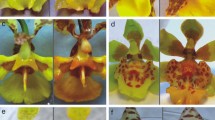Abstract
VOGEL'S report1,2 of the production of glycerides rather than nectar as rewards gathered by bees described an association involving several genera of insects and numerous plant families. We report here that members of the Krameriaceae produce floral lips more unusual than those described by Vogel2. Our data also provide evidence that the oils of Krameria are collected by bees of only one genus, Centris (Anthophoridae), and used, mixed with pollen, as larval food.
Similar content being viewed by others
References
Vogel, S., Abstr. ninth int. bot. Congr., Seattle 299 (1969).
Vogel, S. Naturwissenschaften 58, 58 (1971); ibid 63, 44 (1976); Olblumen und olsammelnde Bienen (Steiner, Wiesbaden, 1974); Fifteenth int. ent. Congr., Washington, D. C., Aug 19–27 (1976).
Michener, C. D. & Lange, R. B. Univ. Kansas Sci. Bull. 39, 69–96 (1958).
Silvestri, F. Redia 1, 1–234 (1903).
Baker, H. G. & Baker, I. in Coevolution of Animals and Plants (ed. Gilbert, L. & Raven, P. H.) 100–140 (University of Texas, Austin, 1975).
Stanley, R. G. & Linskins, H. F. (eds) Pollen: Biology, Biochemistry, Management (Springer, New York, 1974); Lunden, R. Grana Palynol. 1(2), 3–19 (1956).
Author information
Authors and Affiliations
Rights and permissions
About this article
Cite this article
SIMPSON, B., NEFF, J. & SEIGLER, D. Krameria, free fatty acids and oil-collecting bees. Nature 267, 150–151 (1977). https://doi.org/10.1038/267150a0
Received:
Accepted:
Issue Date:
DOI: https://doi.org/10.1038/267150a0
- Springer Nature Limited
This article is cited by
-
Is the maximum reproductive rate of Centris analis (Hymenoptera, Apidae, Centridini) associated with floral resource availability?
Arthropod-Plant Interactions (2017)
-
Nest Liquid Resources of Several Cavity Nesting Bees in the Genus Centris and the Identification of a Preservative, Levulinic Acid
Journal of Chemical Ecology (2006)





